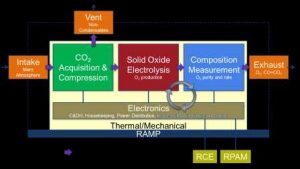MOXIE Generates Oxygen From Carbon Dioxide on the Red Planet
While this is only a first step, affirmation of the concept gives impetus to the idea of humans colonizing Mars in the future.
Unless you have been living under a rock, you must have heard about NASA’s perseverance mission to Mars. It was made famous by 2 recent events. First, is the confirmation of the safe landing of the perseverance rover on February 18, 2021, at the jezero crater by Dr. Swati Mohan, an Indian woman wearing a bindi at NASA, which created quite a buzz. Indians got their vicarious thrill of being represented at the international level. Go, Indians! Second, the ingenuity helicopter, a passenger who hitched a ride aboard the perseverance rover, conducted the first human-orchestrated flight on the red planet on April 19, 2021. To add another feather to its cap, the perseverance rover had another surprise in store for us. You know the usual future-altering kind.
rover on February 18, 2021, at the jezero crater by Dr. Swati Mohan, an Indian woman wearing a bindi at NASA, which created quite a buzz. Indians got their vicarious thrill of being represented at the international level. Go, Indians! Second, the ingenuity helicopter, a passenger who hitched a ride aboard the perseverance rover, conducted the first human-orchestrated flight on the red planet on April 19, 2021. To add another feather to its cap, the perseverance rover had another surprise in store for us. You know the usual future-altering kind.
The perseverance rover had a toaster-sized instrument, weighing 17.1 kg, sitting inside its belly- MOXIE. I know, I know, NASA did it again. It has a real knack for coming up with cool names for its instruments.
Also Read : Brace Yourself! It Is 100 Seconds to Apocalypse
MOXIE stands for ‘Mars OXygen In-situ resource utilization Experiment’. Its objective is to create oxygen using carbon dioxide from the thin Martian atmosphere. And it succeeded in doing just that on April 20, 2021. The Martian atmosphere has a surplus of CO2, 95% by volume. Oxygen makes up a teeny tiny 0.16% in comparison. Think about the numerous applications of this development. We humans kind of need oxygen to not die of anoxia. MOXIE generated 5.4 g of oxygen in an hour in its first test run, capable of providing 10 minutes of breathing time to a human. Its maximum potential is 12g/hour, equivalent to a large tree.
Oxygen is required in the rocket fuel as well as for breathing. Figure this, to launch four astronauts off mars, 7 metric tons of rocket propellant and about 25 metric tons of oxygen are required. The astronauts, however, will need one metric ton of oxygen between them to last a year on the surface.
Bear in mind that MOXIE is just the prototype. It is testing the waters, so to say. To have any viable effect on oxygen supply on Mars, the actual instrument will have to be much more efficient than this. Still, the affirmation of the concept gives impetus to the idea of humans colonizing Mars in the future. MIT- designed MOXIE’s principal investigator Michael Hecht puts it aptly, amending the original statement, ‘a small breath for man, a giant leap for humankind’.
Also Read : Mars and Moon to Play Hide and Seek on April 17, 2021
MOXIE collects carbon dioxide from the atmosphere and guides it through 3 systems, each doing a different job. The gas first goes through a CO2 Acquisition and Compression (CAC) system where the carbon dioxide is filtered from the Martian atmosphere and compressed to approximately 1 atm. The pressurized gas is then sent to a Solid OXide Electrolyzer (SOXE). Here, carbon dioxide (CO2) is electrochemically split into carbon monoxide (CO) and oxygen (O). Oxygen atoms regroup to form the diatomic oxygen (O2) that our lungs love. SOXE operates at high temperatures, at 800⁰C to be exact. This condition prerequisites warming up MOXIE for two hours before starting the experiment. There are O2 and CO exhausts that help measure the purity and production rate of oxygen in the next stage called composition measurement. The electric current flowing through SOXE, solely due to the ions flowing through the electrolyte, acts as a measurement of the rate of oxygen production. There are mechanisms in place to regulate the complete process, right from input flow rate to temperature regulation to applied voltage for efficient conduction of the experiment.
This is the first of the many runs that MOXIE will conduct during its stay on the planet, with one hour of operation per experiment planned. Considering the current Covid-19 situation in the country, it looks like in India, just like on mars, oxygen is in short supply.
